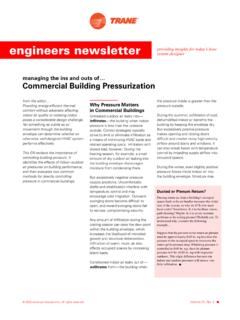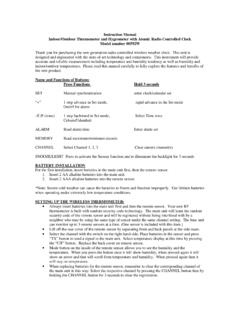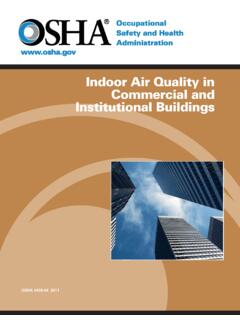Transcription of Indoor Air Unit Conversion Background - US EPA
1 Indoor Air Unit Conversion Background In dilute aqueous systems at room temperature and 1 atmosphere of pressure, 1 liter (L) of water weighs 1 kilogram (kg). Therefore, 1 milligram (mg) of a contaminant in 1 liter (L) of water has a concentration of 1 mg/L, which is the same as 1 mg of containment/1 kg of water on a mass/mass basis. Since there are 1 million mg in 1 kg, the kg in the denominator may be converted to 1 million mg. So our 1 mg/L solution is equivalent to 1 mg/1,000,000 mg. This is referred to as 1 part per million or ppm in aqueous solutions. Similarly, 1 g/L is referred to as 1 part per billion or ppb in dilute aqueous solutions because there are 1 billion micrograms in 1 kg.
2 However, Indoor air units are not expressed as a mass-per-mass ratio, even though they are given as ppm or ppb. The units of ppm and ppb in gas systems are computed on a volume-per-volume ratio and should more accurately be termed ppmV and ppbV. For example: So, how do we convert between the mass-per-volume units and ppmV or ppbV in a gas system? First, we must use the ideal gas law to convert the measured contaminant mass to a volume. The ideal gas law (PV=nRT) relates pressure, volume, temperature and mass of a gaseous contaminant: 1. where Pair is air pressure Vcontaminant is the volume occupied by the contaminant R is the universal gas constant, and Tair is air temperature.
3 ( represents multiplication.) Any units for pressure, volume and temperature may be used, as long as the universal gas constant is in consistent units. Noting that # molescontaminant=masscontaminant/molecul ar weightcontaminant, and using pressure, temperature and volume in units of [kPa], [K[ and [L], we can solve the preceding relationship for the volume of our contaminant, given its mass in grams: 2. Note that T[K] = T[ C] + Now that we have the mass of the contaminant converted to a volume, we simply need to divide by the volume of the sample measurement, and work out the units.]]
4 For example, ppmV is equivalent to 1 mL/m3 and ppbV is equivalent to 1 L/m3. Or in equation form: 3. and So, to convert from g/m3 to ppmV, we plug in our mass values in equation 2 above, making sure to convert our g to units of grams required by the equation. This will give us the volume of our contaminant in liters. We must now convert this into mL for equation 3. Then we simply divide by the sample volume in m3 to obtain our result in ppmV. Likewise, to convert g/m3 to ppbV, we would follow the same procedure, except we d convert the volume of the contaminant to L instead of mL.
5 Example For a numerical example, let s convert g/m3 of benzene to ppmV. We ll assume 25 C and 1 atmosphere pressure ( kPa). So using equation 2, g (which is x 10-6 grams) of benzene (which has a molecular weight of g/mole) occupies the following volume: = x 10-5 L or mL. Dividing this by the sample volume in m3(=1 m3) gives us our result in ppmV: g/m3 of benzene at 25 C and 1 atm pressure = ppmV. For more information, see Introduction to Air Toxics Analyses by Don Harrington of Teledyne instruments. Here are the conversions used in the online calculator, all based on a equations 2 and 3 and appropriate units: g/m3 to ppmV mg/m3 to ppmV g/L to ppmV mg/L to ppmV g/m3 to ppbV mg/m3 to ppbV g/L to ppbV mg/L to ppbV Here are some other useful conversions: ppmV x 1,000 = ppbV


















